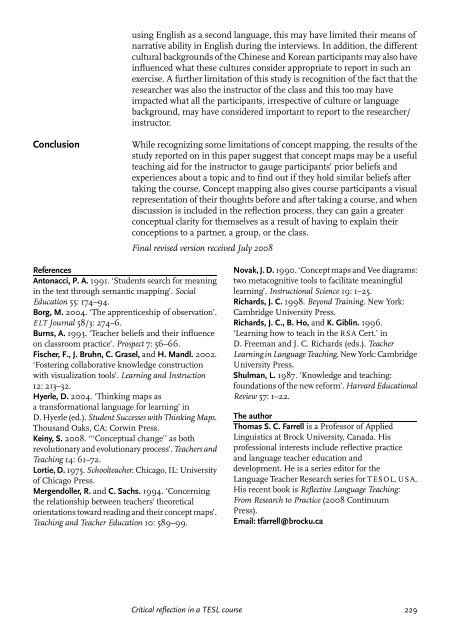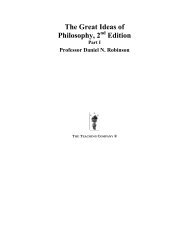Critical reflection in a TESL course: mapping conceptual change
Critical reflection in a TESL course: mapping conceptual change
Critical reflection in a TESL course: mapping conceptual change
You also want an ePaper? Increase the reach of your titles
YUMPU automatically turns print PDFs into web optimized ePapers that Google loves.
us<strong>in</strong>g English as a second language, this may have limited their means of<br />
narrative ability <strong>in</strong> English dur<strong>in</strong>g the <strong>in</strong>terviews. In addition, the different<br />
cultural backgrounds of the Ch<strong>in</strong>ese and Korean participants may also have<br />
<strong>in</strong>fluenced what these cultures consider appropriate to report <strong>in</strong> such an<br />
exercise. A further limitation of this study is recognition of the fact that the<br />
researcher was also the <strong>in</strong>structor of the class and this too may have<br />
impacted what all the participants, irrespective of culture or language<br />
background, may have considered important to report to the researcher/<br />
<strong>in</strong>structor.<br />
Conclusion<br />
While recogniz<strong>in</strong>g some limitations of concept mapp<strong>in</strong>g, the results of the<br />
study reported on <strong>in</strong> this paper suggest that concept maps may be a useful<br />
teach<strong>in</strong>g aid for the <strong>in</strong>structor to gauge participants’ prior beliefs and<br />
experiences about a topic and to f<strong>in</strong>d out if they hold similar beliefs after<br />
tak<strong>in</strong>g the <strong>course</strong>. Concept mapp<strong>in</strong>g also gives <strong>course</strong> participants a visual<br />
representation of their thoughts before and after tak<strong>in</strong>g a <strong>course</strong>, and when<br />
discussion is <strong>in</strong>cluded <strong>in</strong> the <strong>reflection</strong> process, they can ga<strong>in</strong> a greater<br />
<strong>conceptual</strong> clarity for themselves as a result of hav<strong>in</strong>g to expla<strong>in</strong> their<br />
conceptions to a partner, a group, or the class.<br />
F<strong>in</strong>al revised version received July 2008<br />
References<br />
Antonacci, P. A. 1991. ‘Students search for mean<strong>in</strong>g<br />
<strong>in</strong> the text through semantic mapp<strong>in</strong>g’. Social<br />
Education 55: 174–94.<br />
Borg, M. 2004. ‘The apprenticeship of observation’.<br />
ELT Journal 58/3: 274–6.<br />
Burns, A. 1993. ‘Teacher beliefs and their <strong>in</strong>fluence<br />
on classroom practice’. Prospect 7: 56–66.<br />
Fischer, F., J. Bruhn, C. Grasel, and H. Mandl. 2002.<br />
‘Foster<strong>in</strong>g collaborative knowledge construction<br />
with visualization tools’. Learn<strong>in</strong>g and Instruction<br />
12: 213–32.<br />
Hyerle, D. 2004. ‘Th<strong>in</strong>k<strong>in</strong>g maps as<br />
a transformational language for learn<strong>in</strong>g’ <strong>in</strong><br />
D. Hyerle (ed.). Student Successes with Th<strong>in</strong>k<strong>in</strong>g Maps.<br />
Thousand Oaks, CA: Corw<strong>in</strong> Press.<br />
Ke<strong>in</strong>y, S. 2008. ‘‘‘Conceptual <strong>change</strong>’’ as both<br />
revolutionary and evolutionary process’. Teachers and<br />
Teach<strong>in</strong>g 14: 61–72.<br />
Lortie, D. 1975. Schoolteacher. Chicago, IL: University<br />
of Chicago Press.<br />
Mergendoller, R. and C. Sachs. 1994. ‘Concern<strong>in</strong>g<br />
the relationship between teachers’ theoretical<br />
orientations toward read<strong>in</strong>g and their concept maps’.<br />
Teach<strong>in</strong>g and Teacher Education 10: 589–99.<br />
Novak, J. D. 1990. ‘Concept maps and Vee diagrams:<br />
two metacognitive tools to facilitate mean<strong>in</strong>gful<br />
learn<strong>in</strong>g’. Instructional Science 19: 1–25.<br />
Richards, J. C. 1998. Beyond Tra<strong>in</strong><strong>in</strong>g. New York:<br />
Cambridge University Press.<br />
Richards, J. C., B. Ho, and K. Gibl<strong>in</strong>. 1996.<br />
‘Learn<strong>in</strong>g how to teach <strong>in</strong> the RSA Cert.’ <strong>in</strong><br />
D. Freeman and J. C. Richards (eds.). Teacher<br />
Learn<strong>in</strong>g <strong>in</strong> Language Teach<strong>in</strong>g. New York: Cambridge<br />
University Press.<br />
Shulman, L. 1987. ‘Knowledge and teach<strong>in</strong>g:<br />
foundations of the new reform’. Harvard Educational<br />
Review 57: 1–22.<br />
The author<br />
Thomas S. C. Farrell is a Professor of Applied<br />
L<strong>in</strong>guistics at Brock University, Canada. His<br />
professional <strong>in</strong>terests <strong>in</strong>clude reflective practice<br />
and language teacher education and<br />
development. He is a series editor for the<br />
Language Teacher Research series for TESOL, USA.<br />
His recent book is Reflective Language Teach<strong>in</strong>g:<br />
From Research to Practice (2008 Cont<strong>in</strong>uum<br />
Press).<br />
Email: tfarrell@brocku.ca<br />
<strong>Critical</strong> <strong>reflection</strong> <strong>in</strong> a <strong>TESL</strong> <strong>course</strong> 229














